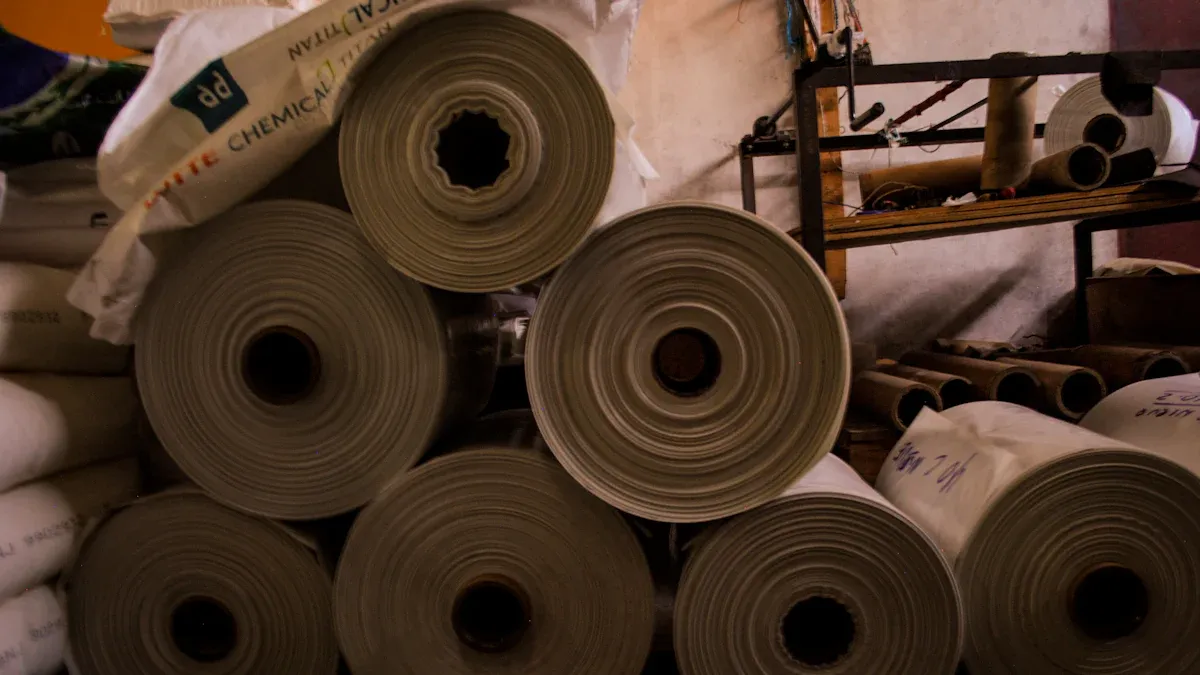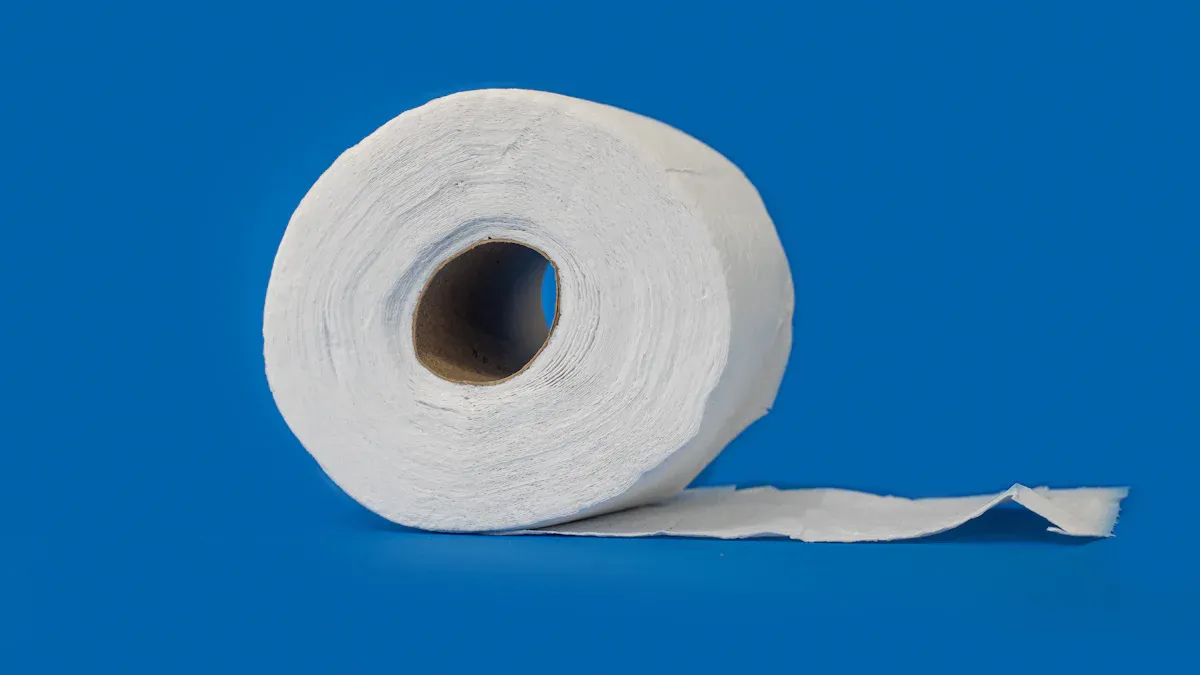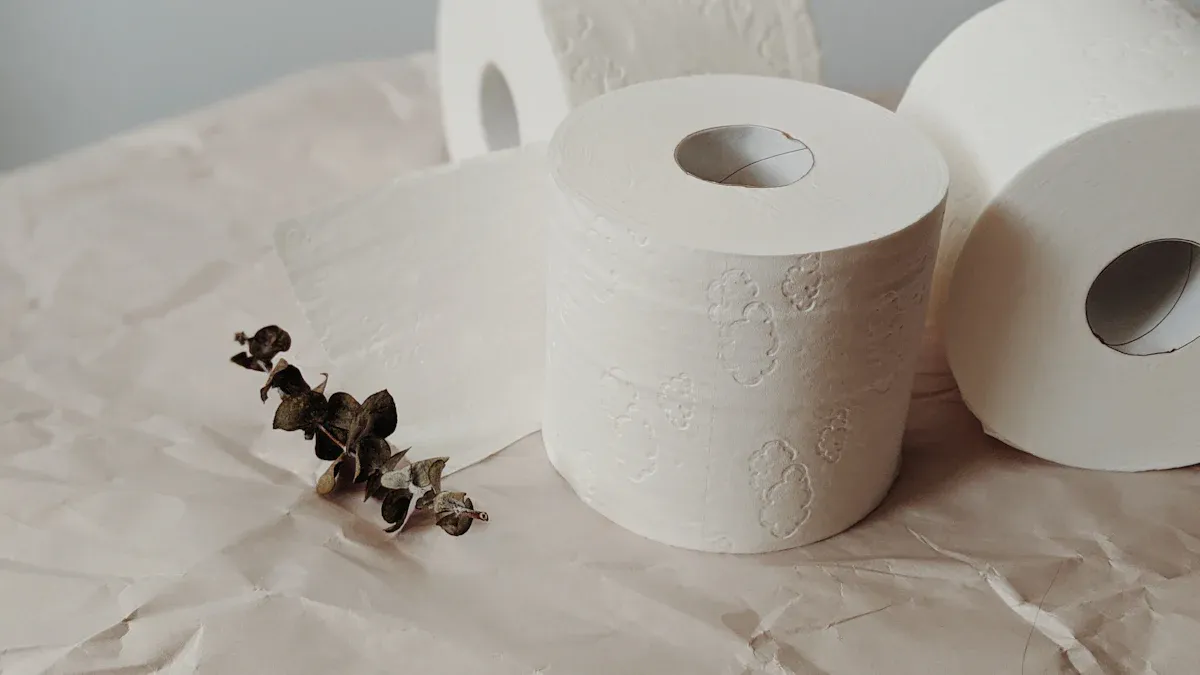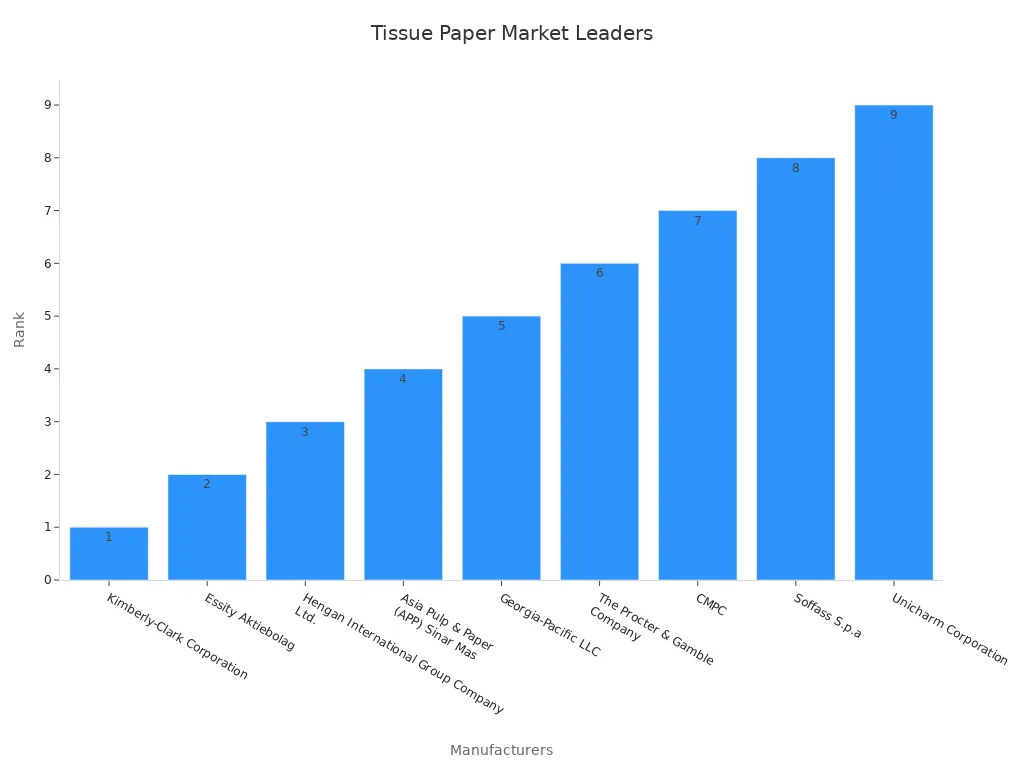
The demand for Jumbo Roll Virgin Tissue Paper is skyrocketing worldwide, thanks to its role in industries like healthcare, hospitality, and manufacturing. Several factors drive this growth:
- The healthcare market, projected to reach $11 trillion by 2026, increasingly relies on disposable tissue products.
- Rising hygiene awareness boosts tissue paper consumption globally.
- The tissue paper market is expected to grow from $82 billion in 2022 to $135.51 billion by 2030.
This versatile product meets the hygiene needs of diverse applications, from medical facilities to household use. Its production relies on high-quality raw material for tissue paper, ensuring safety and effectiveness. Jumbo parent mother roll toilet paper is a key component in this process, and toilet paper roll manufacturers and other industry players recognize its importance in meeting global sanitation demands.
Key Drivers of Demand
Hygiene Awareness and Standards
Hygiene has become a top priority for people worldwide. The COVID-19 pandemic highlighted the importance of cleanliness in preventing diseases. As a result, more individuals and businesses now rely on products like Jumbo Roll Virgin Tissue Paper to maintain high hygiene standards. This tissue paper is widely used in homes, offices, and public spaces because it is effective and convenient.
In North America, consumer awareness about hygiene and sanitization has driven the demand for tissue products. Similarly, in developed countries, tissues are now seen as essential items for everyday use. This shift reflects a growing preference for healthier lifestyles and better sanitation practices.
Population Growth and Urbanization
Population growth and urbanization are major factors behind the rising demand for tissue paper products. As more people move to cities, the need for tissue products in commercial settings like restaurants, offices, and shopping malls increases. Urbanization also brings higher hygiene expectations, encouraging businesses to stock high-quality tissue products.
In the Asia-Pacific region, countries like China, India, and Indonesia are experiencing rapid urbanization. Rising middle-class incomes and government initiatives promoting sanitation have further boosted the demand for Jumbo Roll Virgin Tissue Paper. This trend shows how population growth directly impacts tissue paper consumption, especially in regions with fast-growing economies.
Industrial Applications and Versatility
Jumbo Roll Virgin Tissue Paper plays a vital role across various industries. Its versatility makes it suitable for converting into products like toilet tissue, facial tissue, napkins, and kitchen towels. Industries such as healthcare, hospitality, and manufacturing rely heavily on these products to meet their operational needs.
The production process highlights its adaptability. High-speed paper machines can produce tissue at an impressive rate of 6,000 feet per minute, ensuring efficiency. Companies like Marcal demonstrate the product’s versatility by offering over 200 brand-coded versions of tissue products. Bath tissue accounts for 45% of their production, while paper towels make up 35%. The remaining products include napkins and facial tissues, showcasing a diverse range of applications.
This adaptability, combined with its high absorbency and premium quality, makes Jumbo Roll Virgin Tissue Paper an indispensable resource for various sectors.
Production and Quality Assurance

Virgin Pulp as a Premium Raw Material
The foundation of high-quality tissue paper lies in its raw materials. Virgin pulp, made from 100% wood fibers, stands out as the gold standard. Unlike pure wood pulp, which may include recycled fibers, virgin pulp ensures superior hygiene and safety. This makes it the preferred choice for products like Jumbo Roll Virgin Tissue Paper, especially in industries where cleanliness is non-negotiable.
Virgin pulp offers unmatched softness and strength. It undergoes a meticulous process, starting with wood chips that are cooked and refined to extract pure fibers. This process eliminates contaminants, ensuring the final product is safe for everyday use. For families and businesses alike, choosing tissue paper made from virgin pulp is a step toward better health and hygiene.
Manufacturing Innovations for High Absorbency
Advancements in manufacturing have revolutionized tissue paper production. Modern techniques focus on enhancing absorbency while maintaining softness and durability. For instance, technologies like Through-Air Drying (TAD) create tissue with high bulk and exceptional water absorption. This method also improves softness, making it ideal for premium products.
A closer look at pulp types reveals how innovation impacts absorbency:
| Pulp Type | Absorbency Impact | Additional Notes |
|---|---|---|
| Refined Fibers | Higher absorbency | Better compromise of properties compared to MFC |
| MFC Addition | Lower absorbency | 20% lower capacity than refined fibers at same strength |
Similarly, the choice of raw materials plays a crucial role:
| Pulp Type | Water Absorption | Bulk Softness | Additional Notes |
|---|---|---|---|
| Bleached Softwood | Lower | Lower | Higher tensile strength |
| Bleached Hardwood | Higher | Higher | Better water absorption and softness |
Innovative machinery also contributes to better performance. Valmet Advantage eTAD technology, for example, combines pressing and Rush Transfer techniques to enhance absorbency. This approach not only improves the quality of Jumbo Roll Virgin Tissue Paper but also reduces energy consumption, making it a win-win for manufacturers and consumers.
Sustainability in Production Processes
Sustainability has become a cornerstone of tissue paper production. Manufacturers are adopting eco-friendly practices to minimize their environmental footprint. These efforts include optimizing water and energy usage, reducing waste, and using renewable resources.
Key advancements in sustainable production include:
- Use of recycled materials to reduce reliance on virgin pulp.
- Adoption of energy-efficient machinery to lower carbon emissions.
- Compliance with global sustainability standards to meet consumer expectations.
The tissue paper market is also seeing significant growth, driven by these innovations. By 2029, the market size is projected to reach USD 1.70 billion, with a compound annual growth rate (CAGR) of 3.54%. This growth reflects the industry’s commitment to balancing quality with environmental responsibility.
Sustainability doesn’t just benefit the planet—it also enhances product appeal. Consumers increasingly prefer eco-friendly options, making sustainable practices a competitive advantage for manufacturers. Jumbo Roll Virgin Tissue Paper, produced with these principles in mind, meets both consumer demands and global sustainability goals.
Market Trends and Regional Insights

Eco-Friendly Product Preferences
Consumers today are more conscious of their environmental impact. This shift has led to a growing demand for eco-friendly tissue paper products. Biodegradable options, made from natural fibers, are gaining popularity because they decompose easily and reduce landfill waste. The market for eco-friendly toilet paper reflects this trend. It was valued at USD 1.26 billion in 2024 and is projected to reach USD 2.45 billion by 2033, growing at an impressive CAGR of 8.1%.
The numbers tell a compelling story. By 2027, the eco-friendly tissue paper market is expected to hit USD 5.7 billion, with a CAGR of 4.5%. This growth highlights the increasing preference for sustainable alternatives. Every day, approximately 27,000 trees are cut down for toilet paper production. This alarming statistic underscores the need for products that prioritize sustainability.
Regional Demand Variations
Demand for Jumbo Roll Virgin Tissue Paper varies across regions. In North America and Europe, consumers prioritize premium-quality tissue products. These regions also show a strong preference for eco-friendly options, driven by stricter environmental regulations and higher awareness.
In contrast, the Asia-Pacific region experiences rapid growth due to urbanization and rising incomes. Countries like China and India are seeing increased demand for tissue products in both residential and commercial settings. Government initiatives promoting sanitation further boost this trend. Meanwhile, in Latin America and Africa, the market is expanding as access to hygiene products improves.
E-commerce and Market Expansion
E-commerce has transformed how consumers purchase tissue paper. Online platforms offer convenience, variety, and competitive pricing, making them a preferred choice for many. The COVID-19 pandemic accelerated this shift, as more people turned to online shopping for safety and ease.
Brands benefit from e-commerce by reaching wider audiences and offering promotions that drive sales. Consumers enjoy the ability to filter and sort products based on their preferences, enhancing their shopping experience. Discounts and attractive pricing further encourage purchases, contributing to the tissue paper market’s growth.
This digital transformation has opened new opportunities for manufacturers. By leveraging online channels, they can expand their reach and cater to the evolving needs of modern consumers.
Industry Contributions and Innovations
Leading Manufacturers and Their Role
The tissue paper industry thrives because of contributions from leading manufacturers. These companies set benchmarks for quality, innovation, and sustainability. Kimberly-Clark Corporation, Essity Aktiebolag, and Hengan International Group lead the market, followed by Asia Pulp & Paper (APP) Sinar Mas and Georgia-Pacific LLC. Their efforts shape the industry and drive growth.
| Rank | Manufacturer |
|---|---|
| 1 | Kimberly-Clark Corporation |
| 2 | Essity Aktiebolag |
| 3 | Hengan International Group Company Ltd. |
| 4 | Asia Pulp & Paper (APP) Sinar Mas |
| 5 | Georgia-Pacific LLC |
| 6 | The Procter & Gamble Company |
| 7 | CMPC |
| 8 | Soffass S.p.a |
| 9 | Unicharm Corporation |

These companies focus on customer satisfaction and hygiene awareness. Their innovations cater to growing urban populations and rising workforce participation among women. By addressing these trends, they ensure the tissue paper market remains robust and adaptable.
Investments in Sustainable Practices
Sustainability is a priority for major tissue paper manufacturers. They invest heavily in research and development to create eco-friendly products. Biodegradable tissue papers and those made from renewable sources are gaining traction. Bracell, for instance, invested BRL 5 billion in 2023 to build an eco-friendly tissue paper mill in Brazil. This initiative highlights the industry’s commitment to reducing environmental impact.
Manufacturers also enhance product appeal through innovative techniques. Specialized hygiene products and sustainable production methods attract eco-conscious consumers. These efforts align with global sustainability goals and strengthen the industry’s reputation.
Collaborative Efforts to Meet Global Needs
Collaboration drives progress in the tissue paper industry. Manufacturers partner with governments, NGOs, and research institutions to address global hygiene challenges. These partnerships promote sanitation awareness and improve access to tissue products in underserved regions.
Joint ventures also foster innovation. Companies share resources and expertise to develop cutting-edge technologies. Through-Air Drying (TAD) and energy-efficient machinery are examples of advancements born from collaboration. These efforts ensure the industry meets growing demand while prioritizing sustainability.
By working together, manufacturers create solutions that benefit consumers and the planet. Their contributions pave the way for a cleaner, healthier future.
The global demand for Jumbo Roll Virgin Tissue Paper continues to rise, driven by hygiene awareness, urbanization, and versatile applications. Industry leaders invest in sustainable practices and cutting-edge technologies, ensuring quality and eco-friendliness.
Post time: May-03-2025
